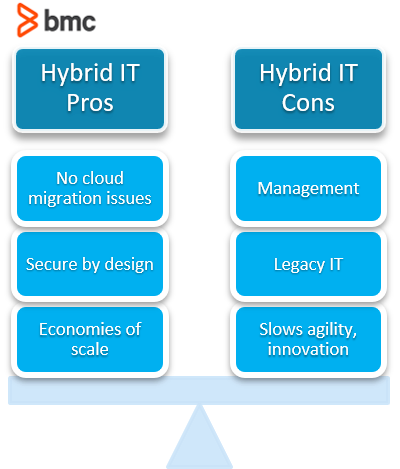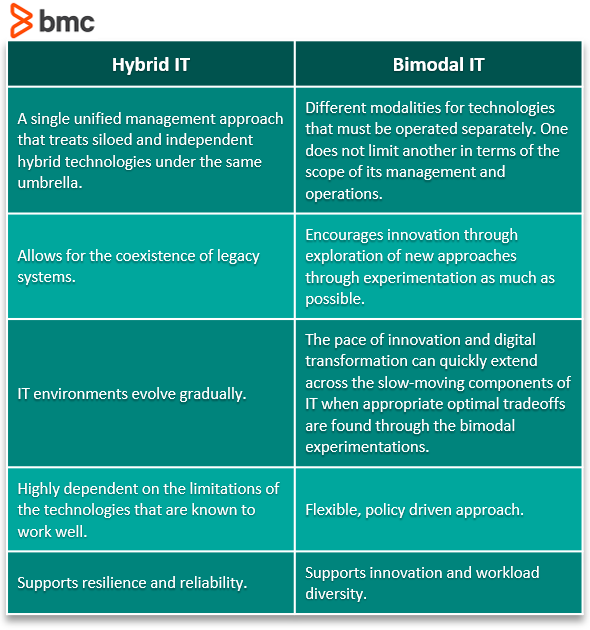Many organizations recognize the need to adopt digital transformation and it modernization initiatives as an opportunity to outperform the competition. The goal for IT departments is to realize the promised goals of digital transformation, such as agility and responsiveness to new market opportunities.
Of course, that means that IT operations and the underlying technologies then require new ways of management. Legacy technologies, that work just well enough, may not support the digital transformation without introducing risky uncertainties into business processes. But, for most organizations modernizing your entire IT infrastructure, systems, and solutions all at once is not possible, likely due to technical or financial limitations. Instead, you can adopt different styles of IT management for various aspects of technologies and business processes.
Two of the popular management strategies for enterprise computing are: Hybrid IT and Bimodal IT. In this article, we will compare Hybrid IT and Bimodal IT and look at:
The challenge for enterprise IT
We all know just how rapidly the enterprise IT industry evolves. Digital transformation requires us to take advantage of the latest and greatest solutions available to enterprise IT users. But such transformation results in myriad challenges in managing an increasingly convoluted IT environment. Here are some common challenges:
Cloud vs onsite data centers
Organizations adopting digital transformation initiatives typically have a variety of technologies to choose from. These technologies are delivered in various operational and service models, ranging from cloud services to onsite data centers and versions in between. Choosing between these models requires a tradeoff in:
- Cost
- Performance
- Security
- Other considerations
Legacy apps won’t modernize
Running legacy technologies is like choosing a lesser problem. Yes, the technologies may have limited support from vendors, replacements for infrastructure components may be rare to find, and experts in the relevant coding languages may no longer be available.
However, modernizing legacy technologies can be a technology challenge, security risk, and a significant cost investment.
The inevitable digital transformation
Cloud migration and modernization of legacy apps are inevitable requirements in the age of digital transformation. This means that organizations must choose to modernize and migrate some app components from on-site datacenters to the cloud. However, they must adopt the new service delivery models and technologies without compromising security or performance.
Until you can achieve a full digital transformation across your entire infrastructure and app technology stack, you’ll have to manually and optimally manage technologies at various phases of the digital transformation maturity spectrum. IT must adopt different styles of work for different technologies, through approaches such as Hybrid IT and Bimodal IT, among others.
Hybrid IT defined
Hybrid IT blends cloud architecture flavors—public, private, hybrid—with in-house data centers in order to deliver data workloads, apps, and services across the hybrid infrastructure environments.
The capability of operating and managing both cloud and on-premise infrastructure technologies as an integrated IT environment allows organizations to take advantage of both. Hybrid IT allows on-premise data center technologies to live side-by-side with the cloud solutions. This often results in a two-pronged approach:
- Sensitive mission-critical and legacy apps can reside within the geographical premise of organizational networks.
- Non-sensitive workloads that require scalable IT resources can run from public cloud environments.

(See how hybrid cloud differs from hybrid IT in Hybrid IT vs Hybrid Cloud: What’s The Difference?)
Bimodal IT defined
Bimodal IT is the practice of managing two separate but coherent styles of work: one focused on predictability; the other on exploration.
These two separate practices are broken into two Modes:
Mode 1: Exploitation
This mode is optimized for predictable, well-understood business processes and IT operations. Mode 1 applies to technologies that work well in terms of its business value. Any changes to the associated IT management and operational style will likely cause more harm than good from a business perspective.
Examples of Mode 1 IT include:
- Troubleshooting
- Improvements
- Deployment of legacy technologies to new projects
Integrating an old technology into a new IT environment designed for a digital world may still require provisions to integrate legacy solutions in the same way as the past.
Mode 2: Exploration
This mode relates with use cases that may be experimental in nature. This is where digital transformation can deliver great business value—but it requires the discovery of the most promising strategies, approach, features, functions and price-points, among other aspects. Furthermore, validating your use case requires exposing it to the real world.
For example, pushing a wrong feature into the market can compromise the market share of your consumer technology. Finding the best feature characteristics can take several iterations of feature releases. Known solutions that have performed well in the past may no longer suffice to win over the change market landscape and user behavior. Therefore, shift to releasing a low fidelity Minimum Viable Products (MVP) offering with continual feedback and improvements until the final product converges to an optimal solution in terms of cost, performance and market reception.
Key differences: Hybrid vs Bimodal
Both the Hybrid IT and Bimodal IT offer a management and operational solution to technologies that may be siloed or cannot be managed within a single integrated and holistic style of management. Below are some of the key differentiating characteristics of Hybrid IT and Bimodal IT:

Additional resources
For more information on this topic, explore these resources:
- BMC IT Operations Blog
- IT Governance vs IT Management: Mastering the Differences
- Public vs Private vs Hybrid: Cloud Differences Explained
- Hybrid Cloud Governance & Compliance
- What Is Enterprise Service Management? (ITSM for the Rest of Us)
These postings are my own and do not necessarily represent BMC's position, strategies, or opinion.
See an error or have a suggestion? Please let us know by emailing blogs@bmc.com.






